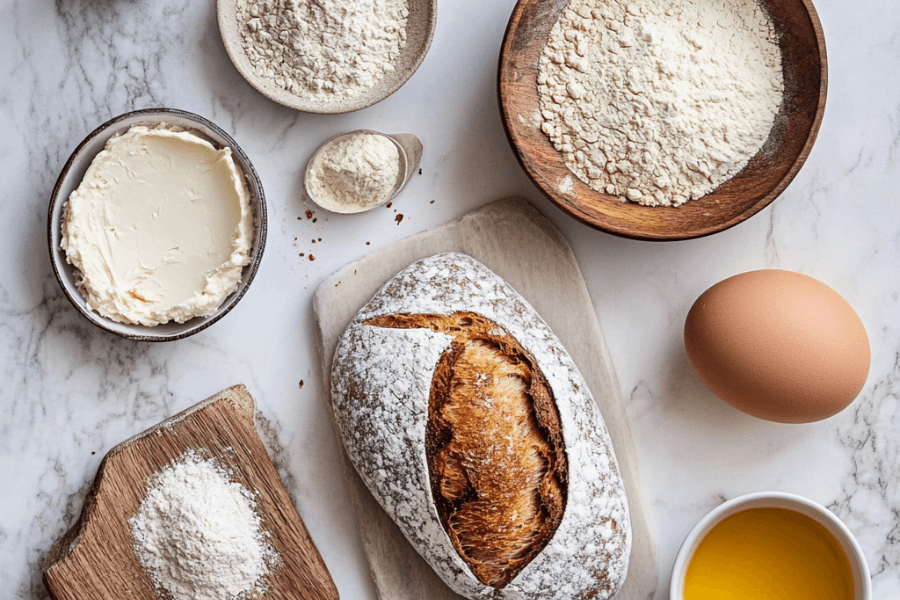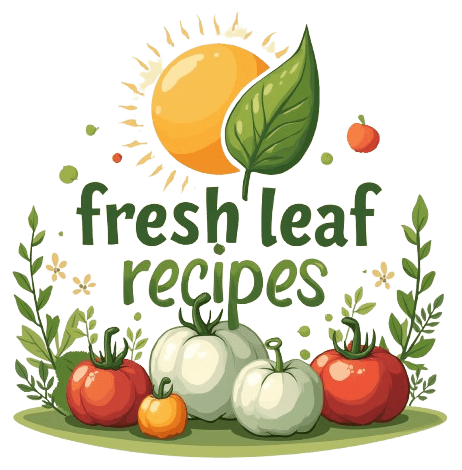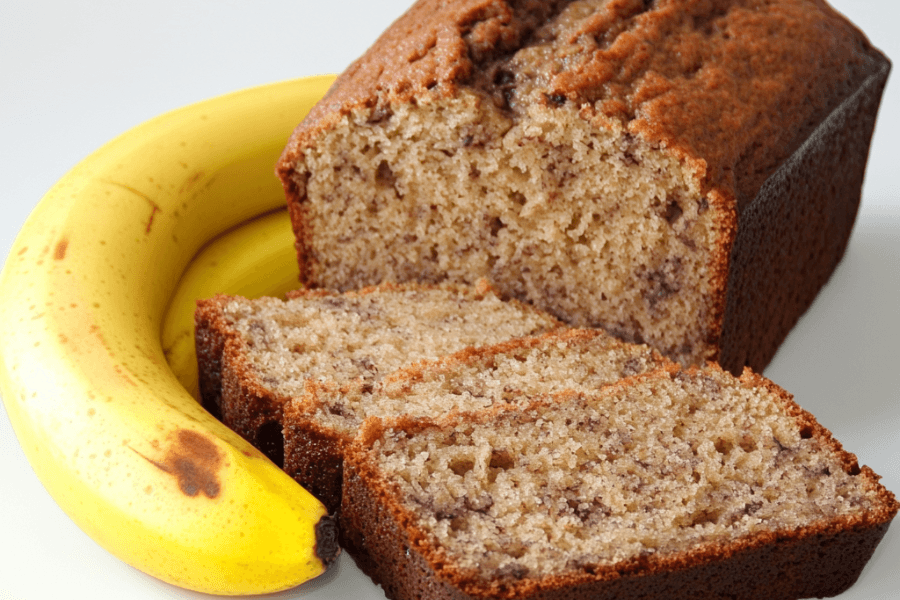If you don’t have baking soda for banana bread, don’t worry—there are several alternatives and adjustments you can make to achieve a delicious result. Baking soda serves as a leavening agent that helps the bread rise and become light and fluffy. Its absence doesn’t mean your banana bread is doomed; you can use substitutes or modify the recipe.
Substitutes for Baking Soda in Banana Bread
- Baking Powder
Baking powder is the most common substitute for baking soda. Since baking powder already contains an acidic component (cream of tartar) and a base (baking soda), you can use it without needing additional acidic ingredients. Use three times the amount of baking powder to replace baking soda.- Example: If the recipe calls for 1 teaspoon of baking soda, use 3 teaspoons of baking powder.
- Self-Rising Flour
Self-rising flour contains baking powder and salt, making it a convenient alternative. Simply replace the all-purpose flour in your recipe with self-rising flour. However, skip adding extra salt, as self-rising flour already includes it. - Egg Whites
Whipping egg whites until they form stiff peaks and folding them into the batter can add air and lightness, helping the bread rise without baking soda. This method works best for recipes that already include eggs. - Club Soda
Club soda can act as a leavening agent due to its carbonation. Replace a portion of the liquid in the recipe with club soda to add lightness. This substitute works better for recipes with a more liquid batter. - Yogurt or Buttermilk with Baking Powder
If you don’t have baking soda but have yogurt or buttermilk, these acidic ingredients can help activate baking powder. Use them in combination with baking powder as your leavening agent.
Table of Contents
Tips for Success
- Adjust the Recipe: Since substitutes like baking powder are less potent than baking soda, the bread may not rise as much. Consider beating the butter and sugar longer to incorporate more air into the batter.
- Flavor and Texture: Without baking soda, the texture might be denser, and the flavor may be less sweet since baking soda helps balance acidity in recipes. To counter this, you can increase the amount of ripe bananas or sugar slightly.
By making these adjustments, you’ll still end up with a moist and flavorful banana bread, even without baking soda.
How to Make Banana Bread Without Baking Soda
Now, let’s dive deeper into the process of baking banana bread without baking soda. Here’s a step-by-step guide to ensure your banana bread still turns out moist, flavorful, and delicious:
1. Adjust the Ingredients
When skipping baking soda, small tweaks to the ingredients can help maintain the flavor and structure of the banana bread.
- Increase the Leavening Agents: If you’re using baking powder as a substitute, remember the rule of thumb: 1 teaspoon of baking soda = 3 teaspoons of baking powder.
- Enhance Sweetness: Baking soda naturally neutralizes the acidic elements in recipes, which can affect the taste. Without it, the bread might taste slightly tangier. Add an extra tablespoon of sugar or honey to balance the flavors.
- Use Overripe Bananas: The riper your bananas, the sweeter and more flavorful your bread will be. Overripe bananas also help improve the bread’s texture.
2. Mix the Batter Carefully
Without baking soda, the method of mixing becomes even more important to incorporate air and create a light texture.
- Cream Butter and Sugar Thoroughly: If your recipe includes butter and sugar, beat them together for 2–3 minutes until the mixture becomes fluffy. This step helps trap air, which will give the bread a lighter crumb.
- Whisk Dry Ingredients: If using baking powder, whisk it thoroughly with the flour and other dry ingredients. This ensures even distribution and better leavening.
- Fold, Don’t Overmix: Once you combine the wet and dry ingredients, gently fold them together. Overmixing can make the bread dense.
3. Experiment with Leavening Alternatives
Each substitute can produce slightly different results, so don’t hesitate to experiment. Below are examples of what you can expect:
- Using Baking Powder: Your bread will rise moderately and have a slightly denser texture than the original recipe.
- Using Whipped Egg Whites: This method produces a fluffier loaf but requires more effort and precision. Make sure to fold the egg whites gently into the batter to avoid deflating them.
- Using Club Soda: While this substitute is less common, it can work well in recipes with thin batter, adding subtle lift and a tender crumb.
4. Monitor Baking Time and Temperature
When making adjustments to the recipe, the baking time and temperature may vary slightly. Here are tips to ensure perfect results:
- Lower the Oven Temperature: Banana bread without baking soda may need a slightly lower oven temperature (around 325°F instead of 350°F) to bake evenly.
- Test for Doneness: Use a toothpick to check if the bread is fully baked. Insert it into the center of the loaf—if it comes out clean or with a few crumbs, it’s ready.
- Avoid Overbaking: Without baking soda, the crust may brown faster. Check your bread 5–10 minutes before the suggested baking time to prevent overcooking.
5. Customize Your Banana Bread
This is also a great opportunity to get creative with your banana bread. Without baking soda, you might want to enhance the flavor or texture with these add-ins:
- Chopped Nuts: Walnuts, pecans, or almonds add crunch.
- Chocolate Chips: For a sweeter twist, stir in some chocolate chips.
- Spices: Cinnamon, nutmeg, or vanilla extract can complement the banana flavor.
- Dried Fruits: Raisins, cranberries, or dried apricots bring a chewy texture.
A Basic No-Baking-Soda Banana Bread Recipe
Here’s a simple recipe to try if you don’t have baking soda:
Ingredients:
- 3 ripe bananas, mashed
- 2 cups all-purpose flour
- 2 teaspoons baking powder
- 1/4 teaspoon salt
- 1/2 cup sugar
- 1/3 cup melted butter or vegetable oil
- 2 large eggs
- 1 teaspoon vanilla extract

Instructions:
- Preheat your oven to 325°F (163°C) and grease a 9×5-inch loaf pan.
- In a bowl, whisk together the flour, baking powder, and salt.
- In another bowl, mix the mashed bananas, sugar, melted butter, eggs, and vanilla extract until smooth.
- Gently fold the dry ingredients into the wet mixture. Avoid overmixing.
- Pour the batter into the prepared loaf pan and smooth the top.
- Bake for 50–60 minutes, or until a toothpick inserted in the center comes out clean.
- Allow the bread to cool in the pan for 10 minutes before transferring it to a wire rack to cool completely.
This recipe yields a moist and flavorful banana bread that doesn’t rely on baking soda.
Common Mistakes to Avoid When Making Banana Bread Without Baking Soda
Baking banana bread without baking soda might seem tricky at first, but avoiding common pitfalls can ensure success. Here are some mistakes to watch out for:
1. Overmixing the Batter
One of the most frequent mistakes when baking is overmixing the batter, especially when you’re making adjustments to the recipe. Overmixing develops gluten in the flour, which can lead to dense, chewy banana bread. Instead:
- Mix Gently: Stir just until the wet and dry ingredients are combined. The batter should look slightly lumpy, not completely smooth.
2. Using Bananas That Aren’t Ripe Enough
The sweetness and moisture of your banana bread depend heavily on the bananas. If you use bananas that are underripe, your bread may lack flavor and moisture.
- What to Do: Use bananas with plenty of brown spots, or even those that appear blackened. These are soft, sweet, and ideal for baking.
If you’re in a hurry and your bananas aren’t ripe yet, try this trick:
- Place the bananas (with the peel) on a baking sheet and bake at 300°F (150°C) for 15–20 minutes. Let them cool before using.
3. Not Using Enough Leavening Substitute
A common issue is underestimating the amount of substitute needed to replace baking soda. If you don’t use enough leavening, your banana bread may end up flat and dense.
- Solution: When using baking powder, remember to use three times the amount of baking soda your recipe calls for. For example, 1 teaspoon of baking soda = 3 teaspoons of baking powder.
4. Ignoring the Importance of Acidic Ingredients
Baking soda typically reacts with acidic ingredients like buttermilk, yogurt, or vinegar to produce carbon dioxide, which helps the bread rise. Without baking soda, your bread may lack that extra lift unless you compensate with acidic alternatives.
- What to Use: Pair substitutes like baking powder with acidic ingredients (buttermilk or yogurt).
5. Not Adjusting Baking Time
Banana bread without baking soda may require a slightly longer baking time, as substitutes like baking powder act more slowly.
- Tip: Monitor your bread carefully, especially in the last 10 minutes of baking. Use a toothpick to test for doneness.
How Different Substitutes Affect Banana Bread
It’s helpful to understand how each substitute impacts the texture, flavor, and rise of your banana bread. Here’s a comparison:
| Substitute | Rise | Texture | Flavor Impact |
| Baking Powder | Moderate | Slightly dense | Neutral—mildly sweet |
| Self-Rising Flour | Good | Light and tender | Slightly salty (reduce added salt) |
| Whipped Egg Whites | High | Light and airy | Adds richness |
| Club Soda | Moderate | Tender | Minimal flavor change |
| Yogurt/Buttermilk | Moderate | Moist and tender | Adds a slight tang |
Frequently Asked Questions (FAQs)
Q1: Can I use baking powder instead of baking soda in all banana bread recipes?
Yes, baking powder can replace baking soda in banana bread recipes. Just remember to use three times the amount of baking powder compared to the amount of baking soda called for in the recipe. Also, adjust other ingredients if needed, especially to balance the acidity and sweetness.
Q2: What happens if I skip both baking soda and substitutes?
If you skip both baking soda and its substitutes, your banana bread will likely be very dense and heavy, with minimal rise. While the flavor might still be good, the texture will be less desirable. Adding whipped egg whites or creaming butter and sugar thoroughly can help compensate for the lack of leavening.
Q3: What’s the best substitute for baking soda in banana bread?
Baking powder is the best substitute because it’s readily available, easy to use, and provides consistent results. It’s a versatile option that works for most banana bread recipes.
Q4: Can I still make moist banana bread without baking soda?
Absolutely! Moist banana bread depends more on the balance of wet and dry ingredients than the leavening agent. Ripe bananas, butter or oil, and eggs ensure the bread stays moist.
Q5: Can I use vinegar or lemon juice as a substitute for baking soda?
Vinegar and lemon juice themselves don’t work as substitutes for baking soda, but they can activate baking powder or whipped egg whites. You can add a teaspoon of vinegar or lemon juice to enhance the rise if you’re using these alternatives.
Q6: Why does my banana bread taste different without baking soda?
Baking soda neutralizes acidity in recipes, which can subtly affect the flavor. Without it, the bread might taste slightly tangier or sweeter, depending on the ingredients. Adding a touch of extra sugar or honey can balance this.
Final Tips for Perfect Banana Bread Without Baking Soda
- Test the Recipe: The first time you make banana bread without baking soda, take note of the results and adjust as needed. For example, you might increase the baking powder slightly or whip the egg whites for extra lift.
- Enhance the Flavor: Adding ingredients like vanilla extract, cinnamon, or nutmeg can make up for any flavor changes caused by the lack of baking soda.
- Experiment: Try different substitutes or combinations, such as baking powder with yogurt or whipped egg whites with a splash of club soda, to find what works best for your recipe.
By following these guidelines and troubleshooting tips, you’ll be able to bake delicious banana bread every time, even without baking soda!
Creative Variations of Banana Bread Without Baking Soda
Once you’ve mastered making banana bread without baking soda, you can experiment with creative variations to elevate the flavor, texture, and appearance of your bread. Here are some unique twists to try:
1. Chocolate Banana Bread
Add a rich, chocolatey flavor to your banana bread for a decadent dessert.
Ingredients to Add:
- 1/3 cup cocoa powder (replace the same amount of flour in the recipe)
- 1/2 cup chocolate chips or chunks
- A sprinkle of sea salt on top for contrast
Tips:
Ensure that you mix the cocoa powder evenly with the dry ingredients to avoid clumps. Chocolate chips will melt into the bread, giving it a gooey texture.
2. Banana Nut Bread
Add crunch and flavor with nuts like walnuts, pecans, or almonds.
Ingredients to Add:
- 1/2 cup chopped walnuts or pecans
- Optional: Toast the nuts in a dry skillet before adding them for enhanced flavor.
Tips:
Fold the nuts gently into the batter at the end of mixing to ensure even distribution.
3. Banana Bread with Swirls
Incorporate swirls of flavor to make your bread visually appealing and taste even better.
Swirl Ideas:
- Cinnamon Swirl: Mix 2 tablespoons of cinnamon with 1/4 cup brown sugar, then swirl it into the batter before baking.
- Nutella Swirl: Add dollops of Nutella on top of the batter and swirl with a knife.
Tips:
When creating the swirl, avoid overmixing to maintain distinct layers of flavor.
4. Vegan Banana Bread Without Baking Soda
For a plant-based version, swap out the dairy and eggs while still achieving great results.
Substitutions:
- Replace eggs with flaxseed eggs (1 tablespoon ground flaxseed + 2.5 tablespoons water = 1 egg).
- Use coconut oil or vegetable oil instead of butter.
- Substitute regular milk with almond milk, soy milk, or oat milk.
Tips:
Ensure the bananas are extra ripe to add sweetness and moisture to the vegan batter.
5. Gluten-Free Banana Bread
Make your banana bread suitable for gluten-sensitive individuals by using alternative flours.
Substitutions:
- Replace all-purpose flour with a gluten-free flour blend.
- Add 1/2 teaspoon xanthan gum if the blend doesn’t include it, to help with structure.
Tips:
Gluten-free flours tend to absorb more liquid, so you may need to increase the amount of bananas or add a splash of milk to prevent dryness.
6. Tropical Banana Bread
Transport your taste buds to the tropics by adding tropical flavors.
Ingredients to Add:
- 1/4 cup shredded coconut
- 1/2 cup crushed pineapple (well-drained)
- 1 teaspoon coconut extract
Tips:
Add the pineapple sparingly, as too much liquid can affect the texture of the bread.
7. Spiced Banana Bread
Enhance your banana bread with warm spices for a cozy, aromatic flavor.
Spices to Add:
- 1 teaspoon cinnamon
- 1/2 teaspoon nutmeg
- 1/4 teaspoon ground cloves
- Optional: 1/4 teaspoon cardamom for a unique twist
Tips:
Combine the spices with the dry ingredients to ensure they’re evenly distributed throughout the batter.
How to Store Banana Bread Without Baking Soda
Banana bread is best enjoyed fresh, but you can store it to maintain its flavor and texture over time. Here’s how:
1. Storing at Room Temperature
- Wrap the banana bread tightly in plastic wrap, aluminum foil, or an airtight container to keep it moist.
- It will stay fresh for up to 2–3 days at room temperature.
2. Refrigerating Banana Bread
- Refrigeration can extend the shelf life to about a week.
- Wrap the bread tightly to prevent it from drying out in the fridge.
- To enjoy it, let it come to room temperature or reheat it slightly in the microwave or oven.
3. Freezing Banana Bread
- Banana bread freezes beautifully, making it a great option for meal prep.
- Wrap individual slices or the entire loaf in plastic wrap, then place them in a freezer-safe bag or container.
- It can be frozen for up to 3 months.
Reheating Tip:
Thaw the bread at room temperature or heat it in the oven at 350°F (175°C) for 10–15 minutes for a freshly baked taste.
For a recipe that doesn’t require leavening agents, try our banana bread without baking soda guide.
Want to experiment further? Check out our 4-ingredient banana bread recipe for minimal ingredient ideas.
For a fruity twist, explore our apple banana bread recipe or banana bread cookies recipe.
Conclusion: Baking Banana Bread Without Baking Soda
Making banana bread without baking soda is easier than it seems, and the results can be just as delicious. Whether you use baking powder, whipped egg whites, or another creative substitute, you can achieve a moist, flavorful loaf that satisfies your cravings.
The key is understanding the role of leavening agents, experimenting with substitutes, and paying close attention to the batter’s texture and baking time. With a little creativity, you can even take your banana bread to the next level with variations like chocolate banana bread, tropical twists, or vegan-friendly options.
For more easy and delicious recipe, check out this: Are All Cakes Gluten-Free? or Gluten-Free Desserts: 10 Delicious Recipes and Expert Tips

